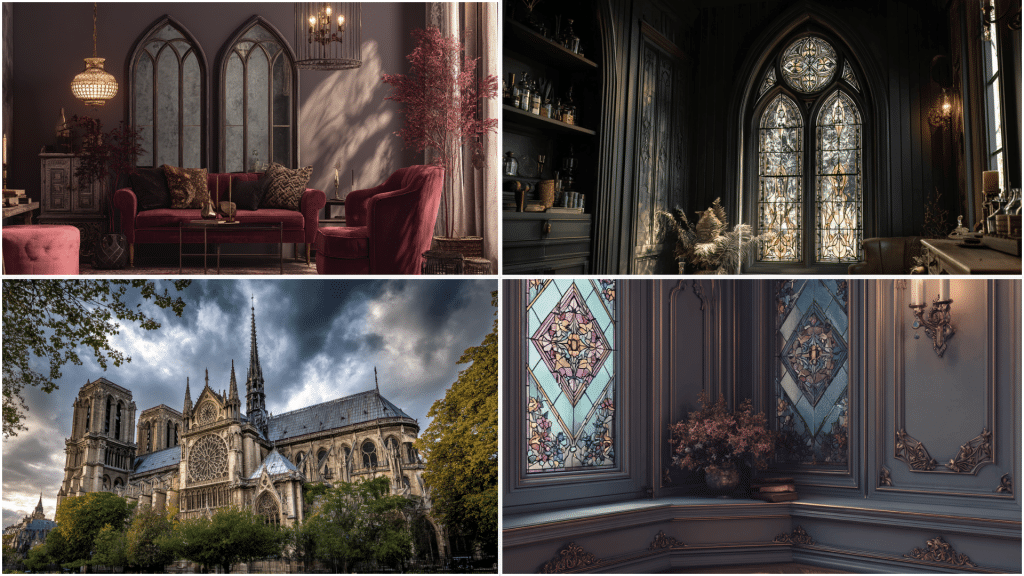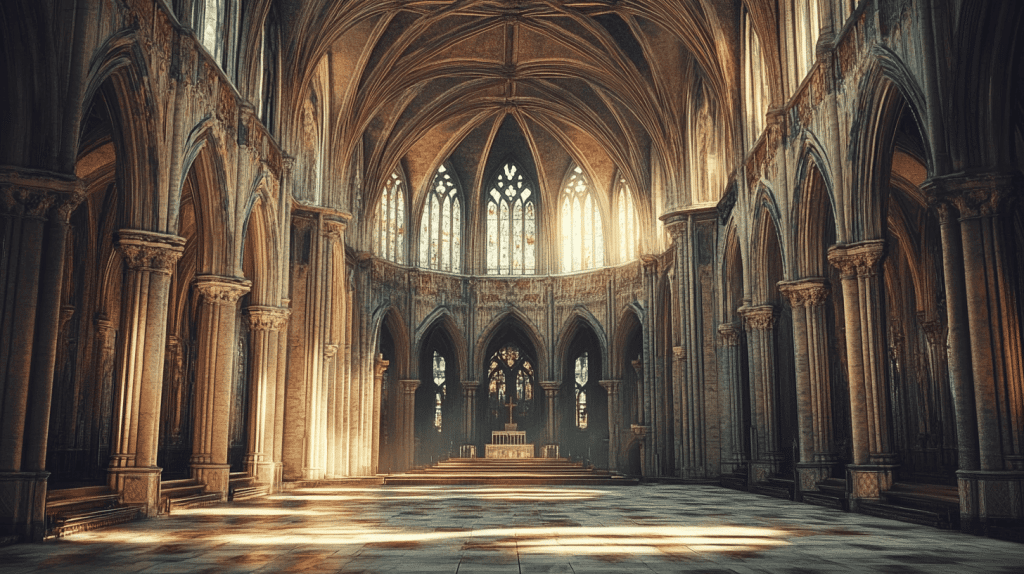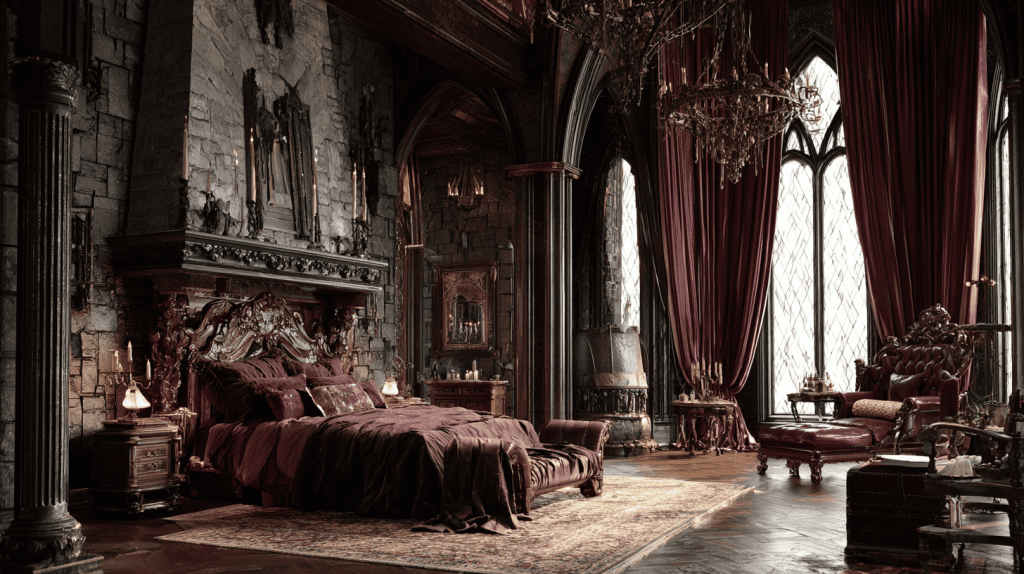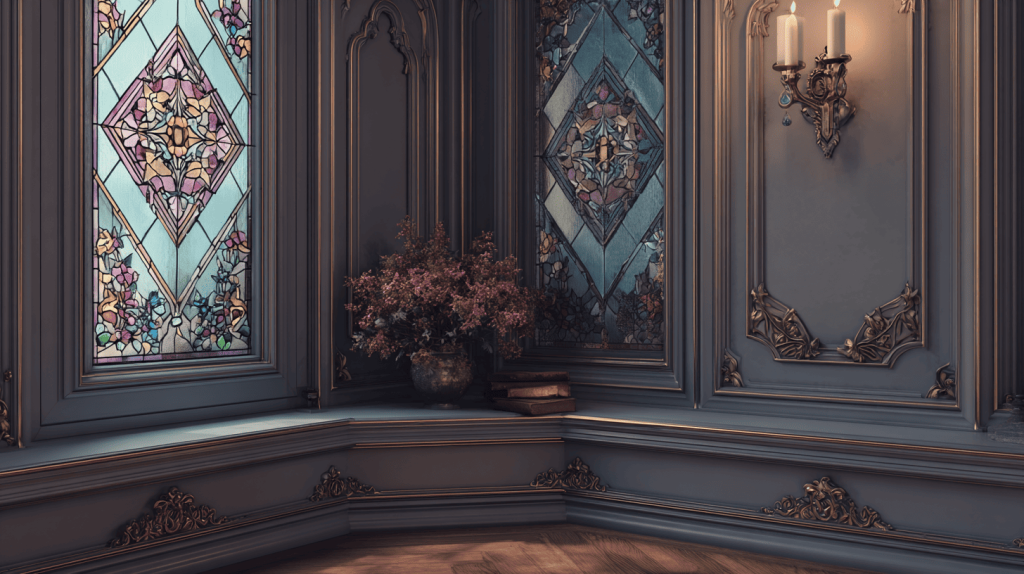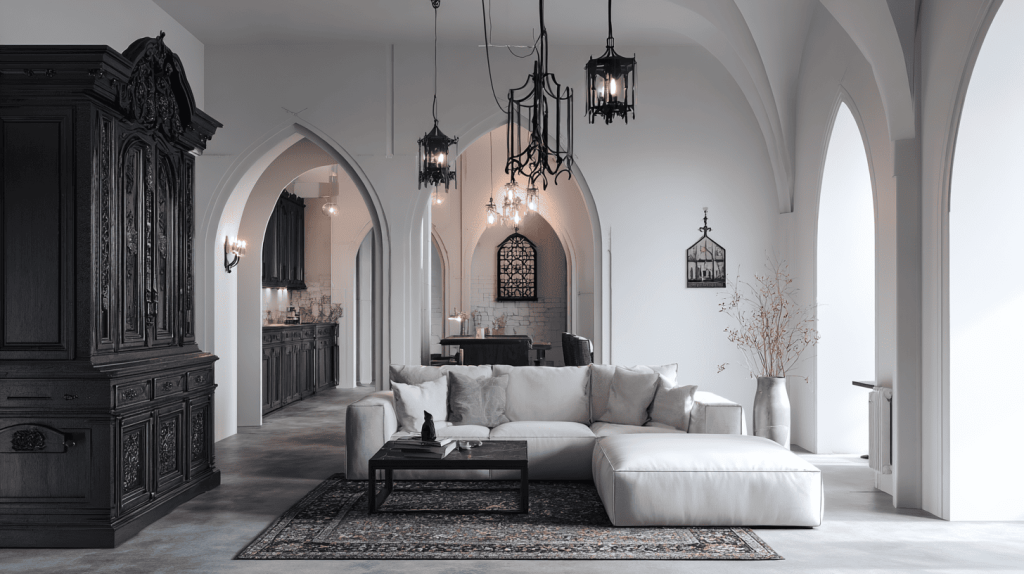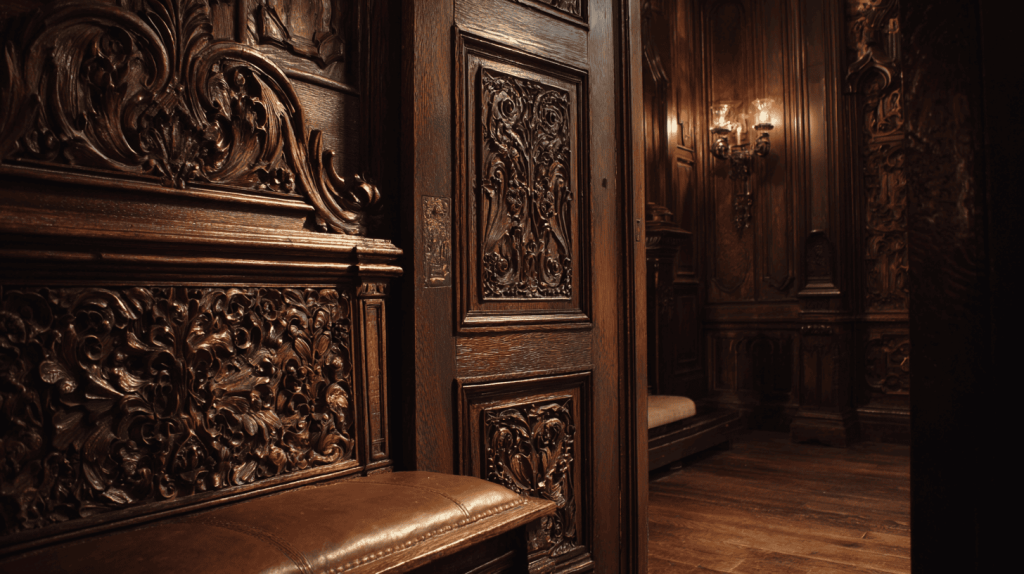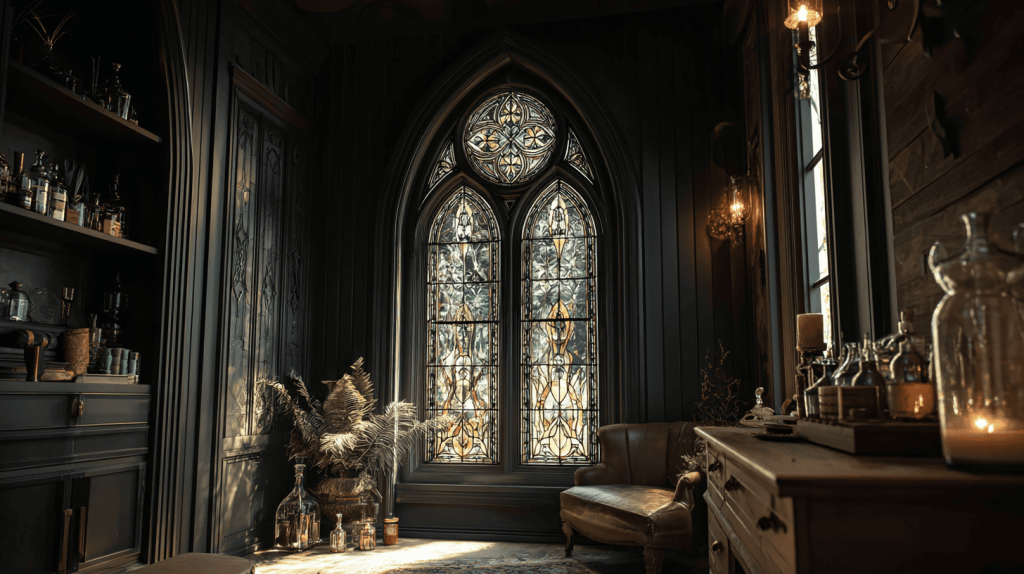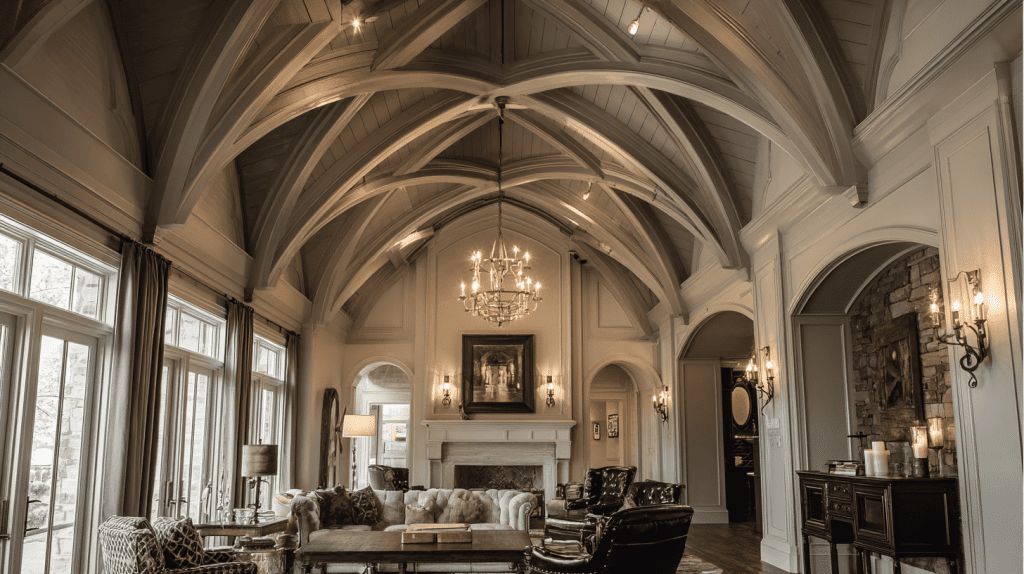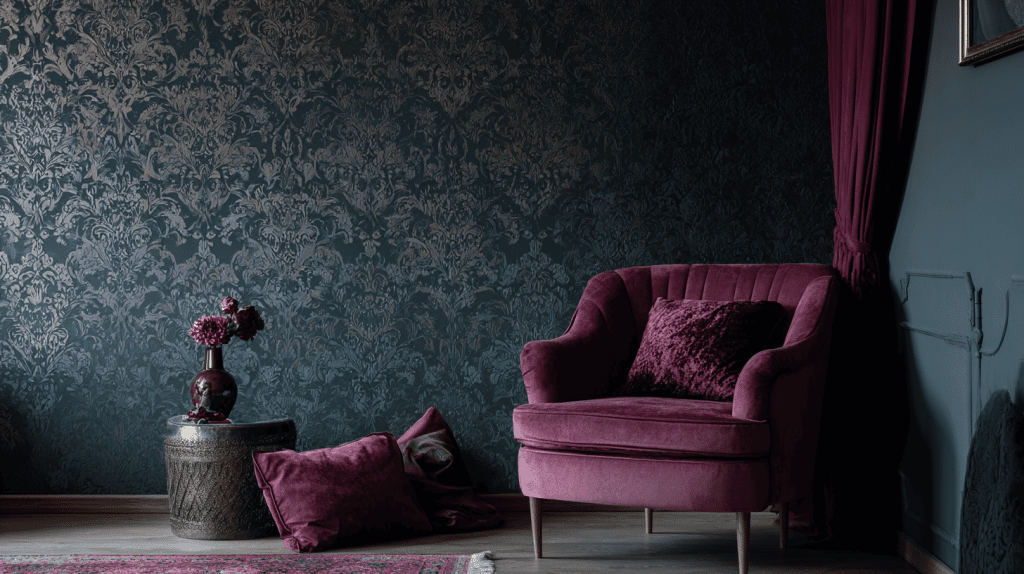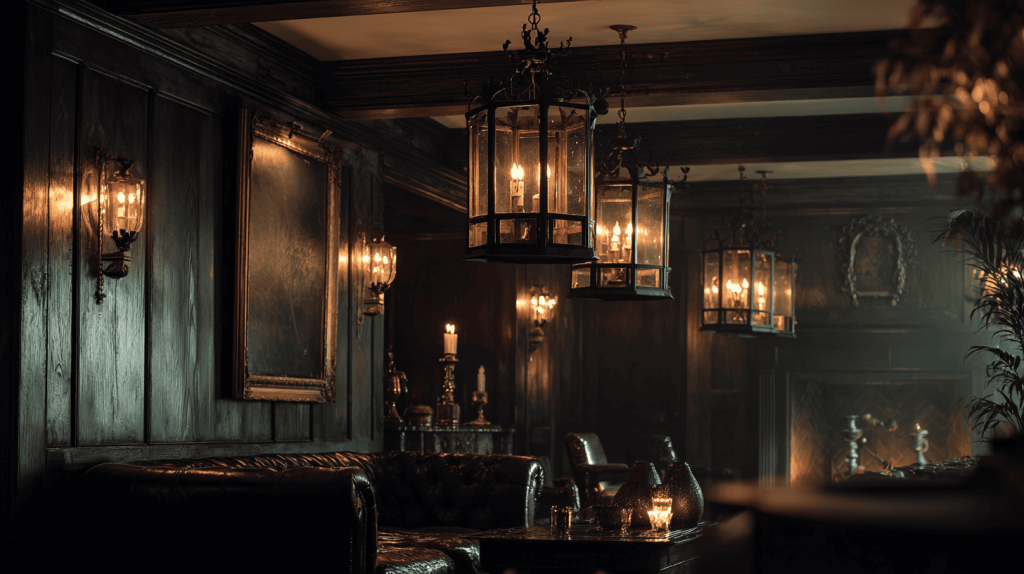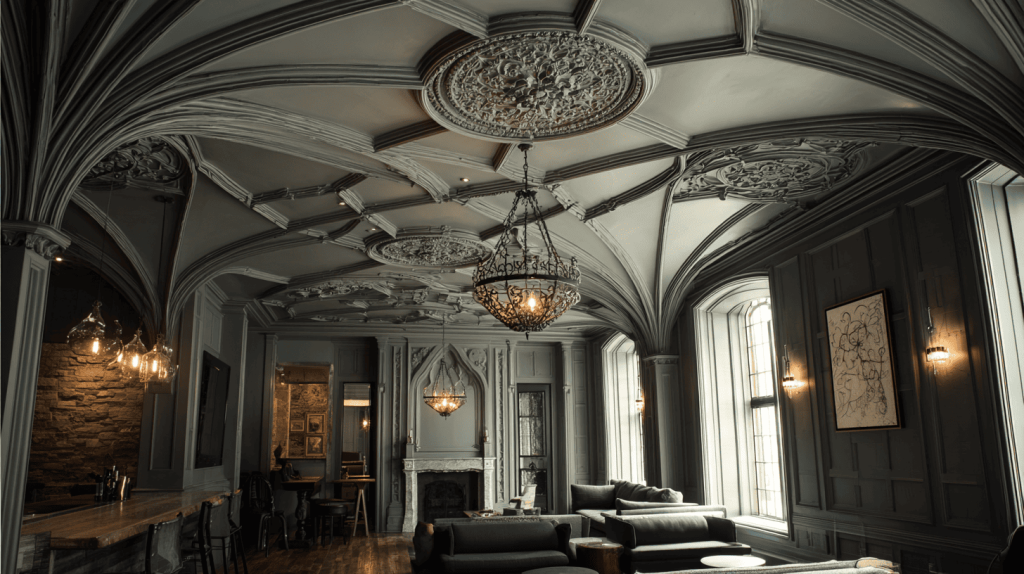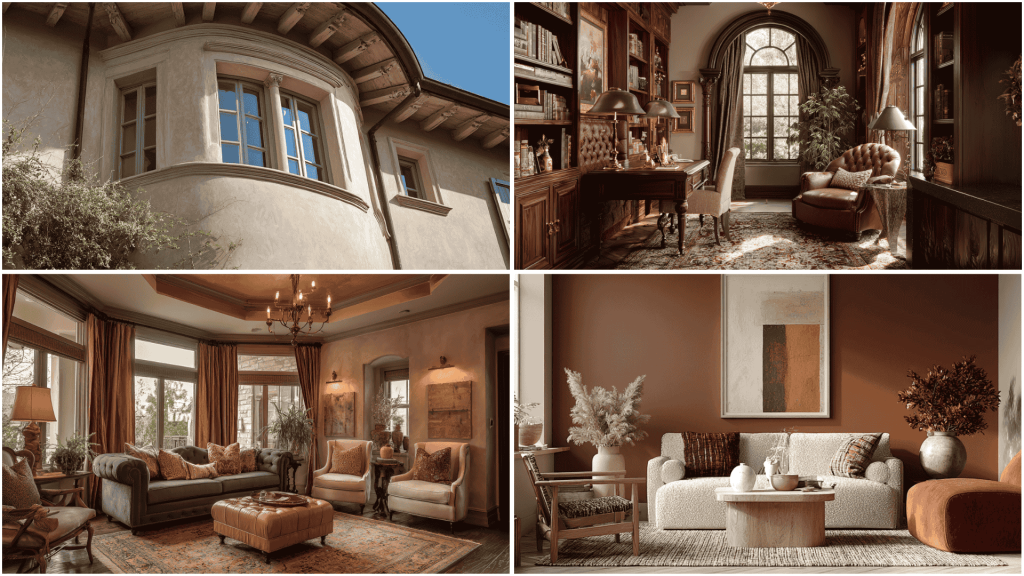Gothic architecture interiors are known for their bold character, intricate details, and timeless charm.
Rooted in Medieval European design.
This style brings a dramatic and emotional atmosphere into space.
Today, many homes are blending these classic features with modern touches, creating interiors that feel both grand and personal.
If you’re drawn to rich textures, moody colours, or architectural drama, the Gothic style offers something unique.
Let’s examine the key elements that define Gothic architecture interiors and how they can inspire your own space.
What Is Gothic Architecture Interior?
Gothic Architecture interior is all about mood, drama, and timeless beauty.
It takes cues from medieval architecture like pointed arches, stained glass, and carved wood.
When you bring these elements into your home, you instantly create a space that feels rich in history and full of character.
I love how it blends old-world charm with modern style.
You don’t need to live in a castle to enjoy it. Just a few touches, such as deep colours, vintage lighting, or a gothic mirror, can completely refresh a room.
If you’re someone who enjoys bold design with a story behind it, this style might speak to you, too.
It’s expressive, artistic, and surprisingly cozy when done right.
Origin of Gothic Architecture
Gothic architecture started in France during the 12th century.
It developed from an earlier style called Romanesque and spread through Europe.
The style is known for its tall buildings and big windows, pointed arches and ribbed vaults are important parts of the design.
Gothic style was mostly used in churches and cathedrals.
It aimed to create a feeling of wonder and let more light inside.
The style remained popular until the 1500s.
Today, Gothic architecture still inspires many designs worldwide.
Is Gothic Architecture Interior In Trend?
Yes, Gothic interior design is definitely making a quiet yet powerful comeback.
People are loving its rich textures, deep colours, and timeless details to create spaces that feel soulful and full of character.
It is not just about being dramatic. It is about telling a story and making your home feel uniquely yours.
It is trending as it lets you showcase your taste beyond trends.
After years of minimalism, many want darker, cosier, more emotional spaces.
Its vintage charm adds a comforting, historic feel.
With the right elements, your space can feel magical and one of a kind.
Elements for Gothic Architecture Interior
Bringing Gothic architecture into your home is all about choosing the correct details.
From colour and texture to furniture and structure, every element plays a part in creating that rich, dramatic feel.
You do not need to live in a castle to enjoy it.
By blending a few classic features with your personal style, you can create a space that feels timeless, expressive, and uniquely your own.
Here are a few key elements that you can add to bring a gothic vibe to your interior.
1. Colours and Patterns
Gothic architecture interiors often begin with rich, moody colours like black, burgundy, emerald, and navy.
These deep tones set a dramatic, grounded mood that feels both rich and mysterious.
Classic patterns like damask and baroque add a sense of history and refinement.
You can bring these elements into your space with wall paint, wallpaper, curtains, or upholstery.
Together, they create a layered, expressive interior that captures the bold and timeless spirit of gothic design.
2. Materials and Textures
Texture plays a significant role in Gothic design.
Velvet, carved wood, wrought iron, marble, and aged stone all add richness and weight.
You can mix soft and hard textures like velvet curtains with a carved wood bed or a stone fireplace with iron lighting.
These materials create a space that feels grounded, luxurious, and full of character.
3. Furniture, Decor and Accessories
Look for statement pieces with intricate details.
Gothic-style furniture often includes tall headboards, arched shapes, and dark finishes.
Decor items like vintage candle holders, antique mirrors, gothic artwork, and stacks of old books help create a lived-in, moody space.
Even one or two bold accents can make a big difference.
4. Gothic Motifs
Gothic interiors often include classic motifs like arches, gargoyles, stained glass, and crosses.
These details can be added through artwork, textiles, or accessories.
You don’t have to go overboard with it.
A single mirror with a pointed frame or a cushion with a Gothic emblem is enough to bring that style in gently.
5. Blending Old with New
You don’t need a full medieval setup.
Modern gothic interiors often combine clean lines with bold, historic accents.
You can think of white walls with black iron light fixtures or a sleek sofa next to an antique wooden cabinet.
The contrast creates balance.
It feels fresh but still soulful and dramatic.
6. Carved Woodwork
Ornate wood adds depth and craftsmanship to any room.
You can think of carved panels, detailed cabinet doors, or a statement headboard.
These elements bring in warmth and a timeless, handmade feel.
Even small touches, like a carved mirror or vintage wooden shelf, can reflect Gothic influences beautifully.
7. Stained Glass Windows
Stained glass is a signature element of Gothic design.
You can use it in windows, cabinet doors, room dividers, or even light fixtures.
It adds colour, texture, and a soft glow when light shines through.
Whether you choose bold patterns or subtle designs, it’s an easy way to bring in beauty and tradition.
8. Pointed Arches
One of the most iconic Gothic shapes, pointed arches can be added in mirrors, doorways, and furniture frames.
They guide the eye upward and add a sense of grandeur.
Even a simple arched mirror or bookshelf can bring this architectural charm into your space without major renovation.
9. Rib Vault Ceilings
Inspired by cathedral architecture, rib vaults create a striking effect.
While a whole vaulted ceiling might be out of reach for most homes.
you can still bring in that feeling with beams, layered ceiling trims, or moulding that mimics the structure.
It draws the eye upward and adds depth.
10. Patterned Wallpapers
Wallpaper is an easy way to bring gothic charm into your home.
Look for baroque florals, damask prints, or rich, dark textures.
Use it on an accent wall or in smaller spaces like a hallway or reading nook.
It adds instant drama and a historical feel without overwhelming the room.
11. Lighting
Gothic interiors glow in a soft, moody light.Use iron chandeliers, lantern-style fixtures, or wall sconces with warm bulbs.
Candle holders also help set the tone.
The key is to avoid harsh overhead light and aim for layers that feel inviting and mysterious.
12. Boss Architecture Details
Bosses are ornamental ceiling details often found in Gothic buildings.
In modern homes, you can use ceiling medallions, mouldings, or even decorative plaster accents to create gothic vibes.
These touches give the ceiling personality and reflect the craftsmanship that defines Gothic architecture.
Famous Buildings That Define Gothic Architecture
Gothic architecture has created some of history’s most breathtaking buildings.
These landmarks not only attract tourists but also inspire design trends, including today’s admired interiors.
These are the few iconic examples that continue to influence Gothic architecture interiors.
- Notre Dame de Paris, France: It is famous for its flying buttresses, tall spires, and dramatic rose windows. The cathedral’s carved stone details and stained glass bring a sense of wonder and spiritual beauty that still shapes gothic interiors.
- Cologne Cathedral, Germany: Towering twin spires and intricate facades define this stunning cathedral. Inside, you will find lofty rib vaults, pointed arches, and richly colored windows that create a deeply atmospheric space.
- Westminster Abbey, England: It is known for its detailed stonework and large arched windows.The soaring ceilings, dark wood elements, and historic charm reflect key features of classic Gothic design used in modern homes.
- Milan Cathedral (Duomo di Milano): It has statues and pinnacles; this cathedral is a masterpiece of Gothic detail. Its white marble spiked arches and ornate windows leave a lasting impression of beauty and strength
- Chartres Cathedral, France: Celebrated for its blue stained glass and sculpted portals. The symmetry, height, and deep symbolism of its interior spaces continue to influence gothic-inspired rooms with a spiritual and artistic feel.
Each of these architectural marvels showcases how Gothic elements, such as pointed arches, ribbed vaults, and intricate stonework, can alter any space into something truly extraordinary.
Wrapping It Up
Gothic architecture interiors bring something truly special to a space.
With rich details, dramatic lines, and a sense of history, every element feels like part of a larger story.
The beauty of this style is that you do not need to fully commit to it.
Just a few well, chosen touches can change the mood of a room.
Think pointed arches, dark wood, ornate mirrors, or a deep, moody colour palette.
These choices add instant character and depth.
This timeless style continues to inspire modern homes in ways that feel fresh, creative, and full of soul, without ever feeling outdated or overwhelming.

